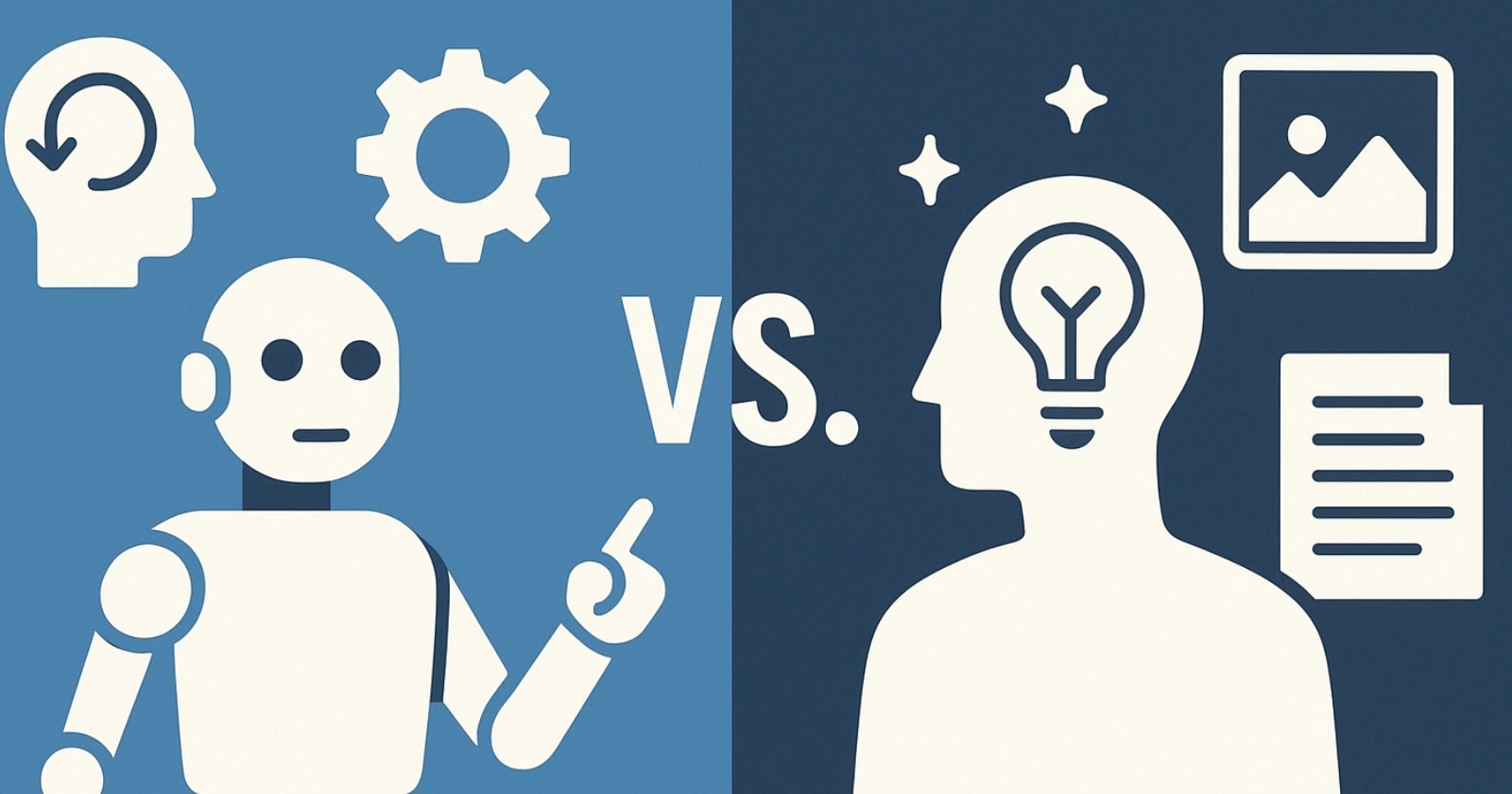Artificial intelligence (AI) has become a cornerstone of modern innovation, transforming how businesses operate, how individuals interact with technology, and how industries evolve. Among the many branches of AI, two emerging paradigms—agentic AI and generative AI—stand out for their unique capabilities and transformative potential. These technologies, while rooted in similar foundations like large language models (LLMs) and machine learning, serve distinctly different purposes. One creates, while the other acts, and together they are redefining the boundaries of what machines can achieve.
Generative AI has captured widespread attention with its ability to produce human-like content, from compelling text to stunning visuals, all based on user prompts. Tools like ChatGPT and DALL·E have become household names, showcasing AI’s creative prowess. Meanwhile, agentic AI, a newer player in the AI landscape, is quietly revolutionizing industries by autonomously executing complex tasks with minimal human oversight. From self-driving cars to automated workflows, agentic AI is about action and decision-making, not just creation.
Understanding the differences between these two forms of AI is crucial for businesses, developers, and individuals looking to harness their power. By exploring their core functionalities, use cases, and future trends, this comprehensive guide sheds light on how agentic AI and generative AI are shaping the technological landscape and what lies ahead for their integration into everyday life.
Defining Generative AI: The Art of Creation
Generative AI is the creative force of the AI world. It leverages advanced machine learning models, such as deep learning neural networks, to generate original content like text, images, videos, music, or code based on user prompts. Trained on vast datasets, generative AI identifies patterns and relationships within the data, enabling it to produce outputs that mimic human creativity. For example, a user might ask a generative AI tool to write a blog post, create a digital artwork, or compose a piece of music, and the system delivers a polished result in seconds.
The strength of generative AI lies in its ability to respond to specific, step-by-step instructions. Tools like OpenAI’s ChatGPT or MidJourney excel at tasks such as drafting emails, summarizing reports, or generating visual designs. However, these systems are inherently reactive, requiring clear user input to function. They do not possess the ability to act independently or pursue broader goals without continuous guidance. Their outputs, while impressive, are limited by the quality and scope of their training data, which can sometimes lead to inaccuracies or biases if not carefully managed.
Despite these limitations, generative AI has become a game-changer across industries. From streamlining content creation for marketers to accelerating software development for coders, its applications are vast and growing. Its adaptability to different contexts and ability to personalize outputs make it a versatile tool for professionals and creators alike.
Understanding Agentic AI: The Power of Autonomy
Agentic AI represents a leap forward in AI’s evolution, focusing on autonomy and goal-driven behavior. Unlike generative AI, which responds to prompts, agentic AI is designed to independently plan, reason, and execute complex tasks to achieve specific objectives. By integrating technologies like LLMs, reinforcement learning, and natural language processing (NLP), agentic AI systems can perceive their environment, make decisions, and adapt to changing conditions with minimal human intervention.
At the heart of agentic AI is its ability to operate proactively. For instance, an agentic AI system in a logistics company might autonomously optimize delivery routes based on real-time traffic data, weather conditions, and shipment priorities. It doesn’t wait for a human to provide step-by-step instructions; instead, it breaks down high-level goals into actionable steps and executes them seamlessly. This autonomy makes agentic AI ideal for applications requiring dynamic decision-making, such as robotics, customer service automation, and financial risk management.
Agentic AI systems often rely on AI agents—specialized components that handle specific tasks within a broader framework. These agents work collaboratively, using shared memory and external tools to achieve complex objectives. For example, in a smart home, agentic AI coordinates individual agents like thermostats and lighting systems to optimize energy consumption based on user preferences and real-time data.
Key Differences: Creativity vs. Action
The distinction between generative AI and agentic AI lies in their core functionalities and objectives. Generative AI is a creative tool, excelling at producing content based on user prompts. Agentic AI, on the other hand, is a decision-making powerhouse, designed to autonomously pursue goals and execute multi-step processes.
Generative AI Vs Agentic AI: Key Features
| Feature | Generative AI | Agentic AI |
|---|---|---|
| Core Function | Creates content (text, images, code, etc.) based on prompts | Plans, reasons, and executes tasks to achieve goals |
| Autonomy | Low; requires user input for each task | High; operates independently with minimal oversight |
| Task Complexity | Handles single, well-defined tasks | Manages complex, multi-step processes |
| Key Strength | Content creation and personalization | Workflow automation and dynamic decision-making |
| Examples | ChatGPT, DALL·E, GitHub Copilot | Autonomous vehicles, smart assistants, AI workflows |
Generative AI operates in a request-response model, producing outputs based on patterns in its training data. It excels at tasks like drafting documents, generating images, or summarizing data but lacks the ability to act independently or adapt to real-time changes. Agentic AI, by contrast, is dynamic, constantly processing new information and adjusting its actions to achieve broader objectives. For example, while generative AI might write a marketing email, agentic AI could automate the entire email campaign, from drafting to scheduling to tracking responses.
Another critical difference is their approach to context. Generative AI uses context to create, drawing on conversational history and training data to produce relevant outputs. Agentic AI uses context to act, leveraging real-time data, environmental conditions, and past actions to make informed decisions. This makes agentic AI more suited for environments requiring adaptability and proactive problem-solving.
Real-World Applications: Where They Shine
Both generative AI and agentic AI have transformative applications across industries, each leveraging their unique strengths to drive efficiency and innovation.
Generative AI Use Cases
- Content Creation for SEO: Businesses use generative AI to produce keyword-optimized blog posts, landing pages, and social media content to boost organic traffic. For instance, a digital marketing agency might use tools like Jasper to create high-quality articles tailored to specific audiences.
- Marketing and Sales: Generative AI powers chatbots and virtual assistants that handle customer inquiries, generate personalized email campaigns, and streamline lead generation. Retail companies, for example, use AI to craft targeted promotions based on customer data.
- Product Design: Generative AI accelerates product development by generating design concepts based on market trends and user preferences. A fashion brand might use AI to create new clothing designs, speeding up the creative process.
- Customer Support: E-commerce platforms employ generative AI chatbots to answer common queries, such as order status or return policies, improving response times and customer satisfaction.
Agentic AI Use Cases
- Customer Service Automation: Agentic AI enhances customer support by autonomously handling complex queries. For example, an AI agent might retrieve customer data, assess intent, and initiate a return process without human intervention.
- Healthcare: Agentic AI is making waves in healthcare, with applications like Propeller Health’s smart inhalers, which monitor patient medication use and environmental factors, alerting providers to potential issues in real time.
- Workflow Management: In logistics, agentic AI optimizes supply chains by autonomously adjusting delivery routes, managing inventory, and forecasting demand based on real-time data.
- Financial Risk Management: Financial institutions use agentic AI to monitor market trends, adjust investment portfolios, and mitigate risks by making data-driven decisions in real time.
How They Work Together: A Synergistic Approach
While generative AI and agentic AI have distinct roles, their true power lies in their ability to complement each other. Many modern AI systems integrate both technologies to create seamless, efficient workflows. For example, a virtual customer service agent might use generative AI to craft personalized responses while relying on agentic AI to manage the conversation flow, retrieve customer data, and execute actions like processing refunds.
In software development, agentic AI can orchestrate multi-step processes, such as debugging code or managing project lifecycles, while generative AI generates the initial code or documentation. Similarly, in robotics, generative AI might create recipes for a robot chef, while agentic AI handles the cooking process, ensuring precision and efficiency.
This synergy is evident in frameworks like LangChain and CrewAI, which combine generative AI’s content creation capabilities with agentic AI’s orchestration and decision-making prowess. By working together, these technologies enable more sophisticated applications, from autonomous marketing teams to intelligent supply chain systems.
Emerging Trends: The Future of AI
The evolution of generative AI and agentic AI is shaping the future of technology, with several trends highlighting their growing impact.
Generative AI Trends
- Personalized Content: Retail and marketing industries are leveraging generative AI for hyper-personalized campaigns, tailoring content to individual preferences based on data analytics.
- Synthetic Data: Generative AI is increasingly used to create synthetic datasets for training models in industries like finance and healthcare, where real-world data may be scarce or sensitive.
- Deepfake Technology: While raising ethical concerns, generative AI’s ability to create hyper-realistic images and videos is driving innovation in entertainment and media, though it requires careful governance to prevent misuse.
Agentic AI Trends
- Robotics and Automation: Companies like Amazon are using agentic AI to power autonomous robots in warehouses, streamlining operations and reducing human intervention.
- City Planning: Agentic AI is being explored for urban planning, analyzing real-time traffic and environmental data to optimize city infrastructure and resource allocation.
- Human Resources: Agentic AI is transforming HR by automating tasks like onboarding, scheduling, and employee support, allowing professionals to focus on strategic priorities.
Governance and Ethical Considerations
As agentic AI and generative AI become more prevalent, governance, safety, and trust are critical concerns. Generative AI’s ability to produce content raises risks of misinformation, biases, and copyright violations. For example, AI-generated deepfakes can spread disinformation, necessitating robust fact-checking and ethical guidelines.
Agentic AI’s autonomy introduces additional challenges. Who is accountable when an autonomous system makes an error? For instance, if an AI agent in a financial system makes a risky investment decision, clear frameworks for oversight and accountability are essential. Security is another concern, as agentic AI’s access to external databases increases the risk of data breaches. Implementing strong security protocols and maintaining human-in-the-loop oversight can mitigate these risks.
Both technologies require transparent governance frameworks to ensure ethical use. Organizations must prioritize accountability, data privacy, and alignment with human values to build trust in AI systems.
Preparing for an AI-Driven Future
The convergence of generative AI and agentic AI is paving the way for a future where machines not only create but also act with purpose. Businesses and individuals must understand their distinct capabilities to leverage them effectively. Generative AI is ideal for content-driven tasks, while agentic AI excels in automating complex workflows and decision-making processes. By combining the two, organizations can achieve unprecedented levels of efficiency and innovation.
For developers, tools like Docker’s Model Runner and orchestration frameworks like LangChain simplify the process of building AI applications. For businesses, adopting AI strategies with clear training programs and ROI metrics is essential to bridge the implementation gap. As AI continues to evolve, staying informed about its capabilities and ethical implications will be key to harnessing its full potential.
The future of AI lies in its ability to seamlessly integrate creation and action. Imagine an AI system that generates innovative marketing strategies and autonomously implements them, or a healthcare platform that creates personalized treatment plans and monitors patient progress in real time. By embracing both generative and agentic AI, society can build a future where technology amplifies human potential while addressing ethical and practical challenges responsibly.
FAQs
- What is the primary difference between generative AI and agentic AI? Generative AI creates content like text or images based on prompts, while agentic AI autonomously plans and executes tasks to achieve specific goals.
- How does generative AI work? Generative AI uses deep learning models trained on large datasets to identify patterns and generate human-like outputs in response to user prompts.
- What makes agentic AI autonomous? Agentic AI leverages LLMs, reinforcement learning, and NLP to perceive environments, make decisions, and execute multi-step tasks with minimal human input.
- Can generative AI and agentic AI work together? Yes, they complement each other. For example, generative AI can create content, while agentic AI manages workflows, as seen in customer service automation.
- What are some real-world applications of generative AI? Generative AI is used for content creation, marketing, product design, and customer support automation, such as generating SEO-optimized blog posts.
- What are the key use cases for agentic AI? Agentic AI excels in customer service automation, healthcare monitoring, workflow management, and financial risk analysis, such as optimizing supply chains.
- What are the ethical concerns with generative AI? Generative AI risks producing misinformation, biases, or deepfakes, requiring robust fact-checking and ethical guidelines to ensure responsible use.
- How does agentic AI handle complex tasks? Agentic AI uses a perceive-plan-act framework, breaking down goals into actionable steps and adapting to real-time data and environmental changes.
- What role does governance play in AI adoption? Governance ensures accountability, transparency, and security, addressing risks like errors in autonomous systems or data privacy breaches.
- What is the future of generative and agentic AI? The future involves integrating both technologies for seamless creation and action, transforming industries like healthcare, logistics, and urban planning.



